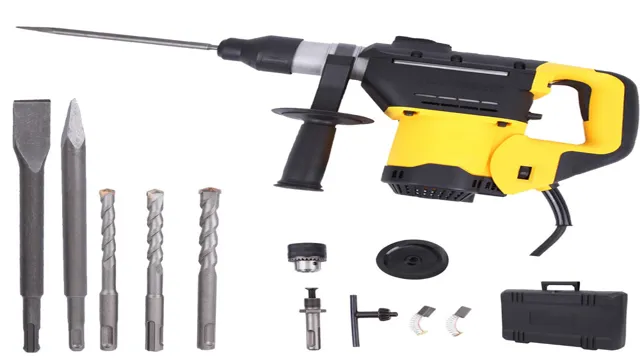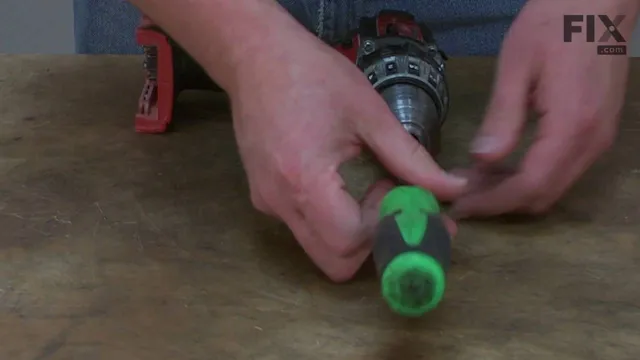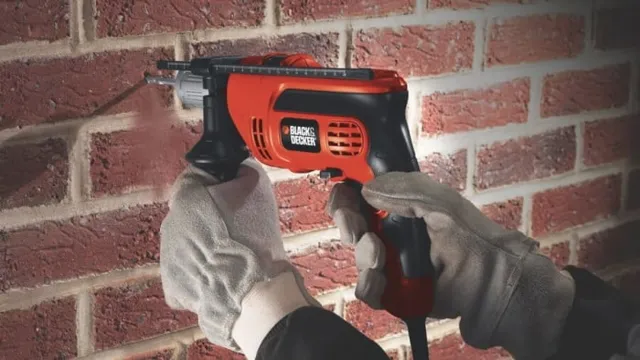Can You Use a Hammer Drill as a Normal Drill? Pros and Cons Explained
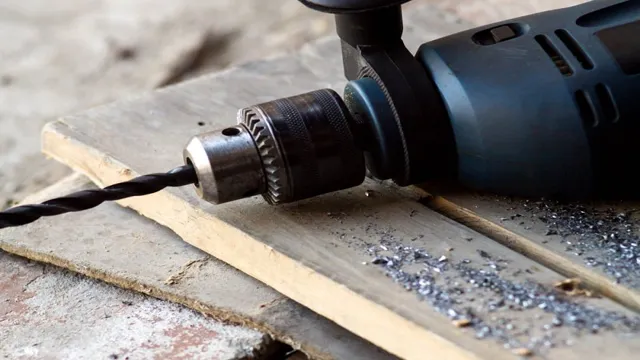
Have you ever wondered if you could use a hammer drill as a normal drill? Well, the answer is yes! Hammer drills are usually associated with drilling through tougher materials like concrete and masonry, but they can also be used for simple drilling tasks. In fact, using a hammer drill as a normal drill can provide more power and speed for your DIY projects. So, whether you’re hanging up shelves or building furniture, a hammer drill can be your perfect ally.
Just like how a Swiss Army Knife can have more than one function, a hammer drill can also be versatile. Stick around as we explore the benefits and ways to use a hammer drill as a normal drill.
Understanding the Difference between a Hammer Drill and a Normal Drill
Many people often get confused about the difference between a hammer drill and a normal drill. While both tools are used for drilling holes, they work in very different ways. A normal drill rotates the drill bit clockwise or counterclockwise, providing a constant, steady movement.
However, a hammer drill not only rotates the bit but also has a pulsating action that pounds the bit into the material it is drilling. The hammering action of a hammer drill makes it essential for drilling into tough materials like concrete and masonry. But can you use a hammer drill as a normal drill? Yes, you can.
While a hammer drill is designed for heavy-duty work, you can switch off the hammering action and use it as a standard drill. This feature is especially useful when drilling holes in wood or metal, where the hammering action is not needed. However, it’s important to note that a hammer drill is usually heavier and more powerful than a regular drill, which means it can be harder to control.
So if you’re only working on light-duty DIY projects, a regular drill may be a better option. In conclusion, a hammer drill and a normal drill are two different tools designed for different purposes. While a hammer drill can be used as a regular drill, it’s important to consider the type of material you’re drilling and whether or not you need the hammering action.
If you’re unsure which tool to use for a particular job, it’s always best to consult with a professional or someone with experience in the field.
Hammer Drill Functionality
When it comes to drilling, you might be wondering what the difference is between a hammer drill and a normal drill. The primary difference lies in their functionality. While a normal drill slowly turns the drill bit to make holes in the material, a hammer drill works with a pulsating motion that helps power through tough surfaces, such as concrete and brick.
The hammer function, often referred to as impact drilling, delivers a rapid-fire punch to the material as it drills, making it easier to make holes. Think of it like using a hammer to break through a brick wall versus just using a chisel and hammer. A hammer drill is also more powerful, with extra torque and speed, making it an ideal tool for heavy-duty drilling projects.
So, if you are looking to tackle a project that involves drilling through tough materials, a hammer drill might be the better option for you.
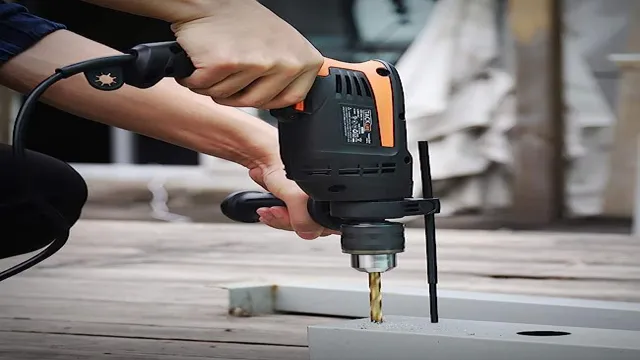
Normal Drill Functionality
Normal drill functionality. If you’re on the market for a new tool, it’s important to understand the difference between a hammer drill and a normal drill. Normal drills are perfect for drilling holes into wood, plastic, metal, or any other soft surface.
These drills are typically compact and lightweight, making them easy to maneuver and control. They operate by rotating the drill bit, which in turn grinds away the surface you’re drilling into. Normal drills come in both corded and cordless varieties, and they’re an essential tool for any DIY enthusiast or professional contractor.
While they work great on softer surfaces, it’s important to note that they may not have enough power to drill into harder surfaces like concrete. So, if you’re planning on drilling into tougher materials, you’ll want to consider a hammer drill instead.
Can a Hammer Drill be Used as a Normal Drill?
If you’re wondering whether you can use a hammer drill as a normal drill, the answer is yes, you can! In fact, hammer drills come with a switch that allows you to turn off the hammering function and use it as a regular drill. However, keep in mind that using a hammer drill as a regular drill may not be as efficient as using a dedicated drill. Hammer drills are designed for tougher jobs that require drilling through harder materials like concrete or masonry, which means they may not be the best choice for lighter tasks that demand a bit more precision.
So, while it’s certainly possible to use a hammer drill as a normal drill, it’s important to consider what type of work you’ll be doing and whether a dedicated drill might be a better choice for the job.
Advantages of using a Hammer Drill as a Normal Drill
Hammer Drill A hammer drill is a versatile power tool that can be used for different applications, including drilling through concrete and masonry. But what if you only need to drill a hole in wood or metal? Can you use a hammer drill as a normal drill? The answer is yes. In fact, using a hammer drill as a normal drill has several advantages.
Firstly, hammer drills are more powerful than normal drills, which means they can drill through tougher materials faster and more efficiently. Secondly, hammer drills have a hammer action that delivers rapid blows to the drill bit, making it easier to drill through hard materials. This function can also come in handy when drilling through soft materials, as it helps to clear the debris from the hole.
Lastly, hammer drills are designed with a clutch that allows the user to control the speed and torque of the drill, making them more versatile than normal drills. Overall, if you own a hammer drill, there is no need to buy a separate normal drill. A hammer drill can be used as a normal drill with the added advantage of being more powerful, efficient, and versatile.
However, it is important to remember to turn off the hammer function when drilling through soft materials, as it can damage the surface. With this in mind, you can make the most of your hammer drill for all your drilling needs, whether it be for wood, metal, or concrete.
Disadvantages of using a Hammer Drill as a Normal Drill
While a hammer drill can indeed be used as a normal drill, it is not always the best option. One of the biggest disadvantages of using a hammer drill as a normal drill is the weight. Due to its heavy and bulky design, a hammer drill can be difficult to maneuver in tight spaces, causing fatigue and discomfort.
Additionally, since a hammer drill is specifically built for drilling into tough materials like concrete, it may not offer the same precision as a normal drill when used on softer materials like wood or drywall. Furthermore, the hammer function can cause unwanted holes or damage to the surface if not used properly. In short, while it is possible to use a hammer drill as a normal drill, it is generally recommended to use a dedicated drill for lighter jobs to avoid potential issues and ensure accuracy.
Safety Considerations when using a Hammer Drill as a Normal Drill
A hammer drill is a powerful tool that has the ability to complete the same tasks as a normal drill, but with the added impact of a hammer mechanism. This impact feature is mainly used for drilling into concrete and masonry material. However, the question remains, can a hammer drill be used as a normal drill? The answer is yes, but there are some important safety considerations to keep in mind.
Firstly, it’s crucial to never turn the hammer function on when you’re working on a softer material, such as wood or plastic. This can cause damage to the material and potentially harm the user. Secondly, ensure that the drill bit is secured tightly in the chuck to avoid it from coming loose during use.
Lastly, always wear the appropriate personal protective equipment such as safety glasses, gloves, and ear protection. By following these simple safety precautions, you can use a hammer drill as a normal drill effectively and safely.
Conclusion
In conclusion, while you technically can use a hammer drill as a normal drill, it’s a bit like using a sledgehammer to put in a thumbtack. It may get the job done, but it’s not the most efficient or precise tool for the job. So, unless you enjoy the thrill of excess power and noisy vibrations, it’s probably best to stick with a regular drill for your everyday DIY projects.
“
When to use a Hammer Drill and When to use a Normal Drill
When it comes to drilling, there are two main tools to choose from: the normal drill and the hammer drill. The hammer drill is ideal for tasks that require drilling through thick and hard materials such as concrete, brick, and stone. This is because the hammer drill uses a hammering motion to create a hole, rather than just a rotating drill bit as with a normal drill.
The hammer drill is also the go-to tool when you need to drill into these tough materials for an extended period, as the drill’s design allows it to withstand the extra pressure and stress. But what about using a hammer drill as a normal drill? The answer is yes, you can. A hammer drill can be used as a normal drill by simply turning off the hammering function.
Although, it is important to note that if you only plan on using a drill for small DIY tasks around the house, a normal drill may be a more practical and cost-effective choice. The hammer drill’s design adds extra weight and bulk, making it harder to handle if you’re not experienced with using power tools. In conclusion, when deciding which drill to use, it depends on the task at hand.
A hammer drill is the go-to if you are working with tough materials such as concrete, and the normal drill may be better suited for smaller household tasks. And, if you do invest in a hammer drill, it can be used as a normal drill as well by turning off the hammering function.
Final Thoughts
Yes, a hammer drill can be used as a normal drill, but there are some important things to keep in mind. First off, hammer drills are designed for drilling into denser materials like concrete or brick, so they are typically much more powerful than regular drills. This means that using a hammer drill for lighter tasks can be overkill and potentially damaging to the surface being drilled into.
Additionally, hammer drills are generally heavier and bulkier than regular drills, which can make them more difficult to manipulate in tight spaces. However, if you already have a hammer drill and need to use it for normal drilling tasks, it can certainly get the job done. Just be sure to adjust the settings accordingly and consider using a lighter touch to avoid damaging the surface.
Remember, a hammer drill is like a sledgehammer while a regular drill is more like a hammer, so choose the right tool for the job to ensure the best results.
FAQs
What is a hammer drill and how does it differ from a normal drill?
A hammer drill is a power tool designed for drilling through masonry or concrete by delivering rapid hammering action. It differs from a normal drill in that it combines drilling with a forceful hammering action to provide extra power when working with harder materials.
Can a hammer drill be used as a normal drill?
Yes, a hammer drill can be used as a normal drill by simply turning off the hammer function. This allows the tool to operate as a regular drill, making it a versatile tool for various drilling applications.
Is a hammer drill more powerful than a normal drill?
Yes, a hammer drill is typically more powerful than a normal drill due to its ability to deliver rapid hammering action in addition to drilling. This extra power makes it ideal for drilling into harder materials such as concrete, brick, or stone.
What types of materials can a hammer drill be used on?
A hammer drill can be used on a variety of materials, including concrete, brick, stone, masonry, and wood. However, it is important to use the appropriate drill bit for the material being drilled to ensure optimal performance and avoid damage to the tool.
What are the advantages of using a hammer drill over a normal drill?
The advantages of using a hammer drill over a normal drill include faster drilling times, more power, increased precision, and the ability to work with harder materials. Additionally, many hammer drills also have a variable speed feature, allowing for greater control and versatility.
Are there any disadvantages to using a hammer drill?
Some of the disadvantages of using a hammer drill include the increased weight and size of the tool, which can make it more difficult to use in tight spaces or for prolonged periods of time. Additionally, hammer drills can be more expensive than normal drills, making them less accessible to some users.
Can a hammer drill be used for tasks other than drilling?
Yes, some hammer drills come with additional modes or features that make them suitable for tasks other than drilling. For example, some models may include a chisel mode for breaking up concrete or a screwdriver mode for driving screws. However, it is important to read the manufacturer’s instructions and use caution when using these features.

